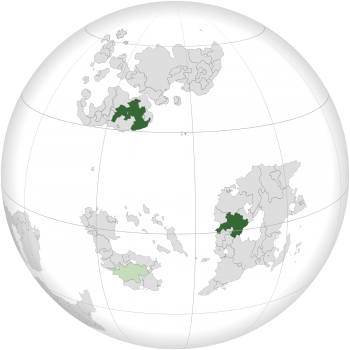Union of Sovereign States
 | |
| Headquarters | |
| Official languages | |
| Type | IGO |
| Membership | |
| Leaders | |
• Chairman of the General Assembly | |
• Chairman of the Council of Ministers | |
• Chairman of the Security Council | |
| Establishment | 25 May 2015 |
| Area | |
• Total | 1,627,753 km2 (628,479 sq mi) |
| Population | |
• Estimate | 106,685,242 |
| Currency |
|
a. Secretariat. b. General Assembly. | |
The Union of Sovereign States (USS; Arabic: اتحاد الدول ذات السيادة; Jindalean: 주권 국가 의 연합; Lettucian: Unió d'Stats Suberans; Spanish: Unión de Estados Soberanos) is an international organization consisting of the Arab Republic of Gandhara, the Bolivarian Republic of Lettuce, and the Democratic People's Republic of Jindalea. The USS was established on 25 May 2015 to promote international cooperation between the member states.
Creation
The Union was formed with the signing of the "Treaty on the Creation of a Union between DPR Jindalea and Gandhara".[1] On 11 June 2015, Lettuce officially joined the Union.[2] According to the Preamble of the Treaty, the official name of the Union is the Union of Sovereign States, reflecting the sovereignty of its members. The USS is an intergovernmental organization whose overarching aim is promoting comprehensive cooperation among the member states.
Institutions and legal framework
The member states retain their own sovereignty and international personality, meaning that DPR Jindalea,Gandhara, and Lettuce are still fully responsible for their own internal affairs and external relations. The Union itself cannot claim representation in other international organizations or overrule legislation or government decisions of its member states.
The Treaty on the Creation of a Union between DPR Jindalea and Gandhara has established four institutions: a General Assembly, a Council of Ministers, a Security Council, and a Secretariat.
General Assembly
The General Assembly is the main deliberative assembly of the Union. The assembly meets every 6 months, but emergency sessions can also be called. The assembly is presided over by the President whose country holds the chairmanship, and is located in Rhea.
Council of Ministers
Composed of the member states' Prime Ministers, Ministers of Foreign Affairs, Economy, and Finance, the Council of Ministers assists the General Assembly in promoting political, cultural, and economical cooperation between the member states. The Council also discusses about mutual foreign affairs of the member states, and advises the General Assembly on matters of international relations.
Security Council
The Security Council is charged with maintaining peace and security among the member states. The Council consists of 18 members, 6 from each member state. Its powers include the authorization of military action through resolutions. Security Council resolutions will be enforced by military forces voluntarily provided by member states. As the function of the Security Council is the protection of the lives and properties of its subjects, it will only act if either signatory becomes involved in war. The governments of the member states hold veto power over resolutions.
Secretariat
All activities of the Union are coordinated and monitored by its Secretariat, which is located in Sanggumdang. The Secretary-General is the head of the Secretariat, and also acts as the de facto spokesperson and leader of the Union.
Developments
Flag and coat of arms
Since the formation of the Union, there has not been official recognition of a flag or coat of arms. During official meetings, the flags of DPR Jindalea, Gandhara, and Lettuce are used, which clearly depicts the sovereignty of these countries. Another reason to keep using national flags is that, although the member states have strong ties, the difference between their cultures makes it difficult to create a flag that represents all nations.
Expansion
According to the Treaty, it is possible for other countries to join the Union. The governments of the member states have to give their approval to the accession of new member states. After the approval of the member states, the accession of a new member state will be effected by a decision of the General Assembly. Lettuce was the first country to join the Union on 11 June 2015.
References
- ^ "Creation of the Union of Sovereign States". 25 May 2015.
- ^ "Lettuce officially joins the Union". 11 June 2015.